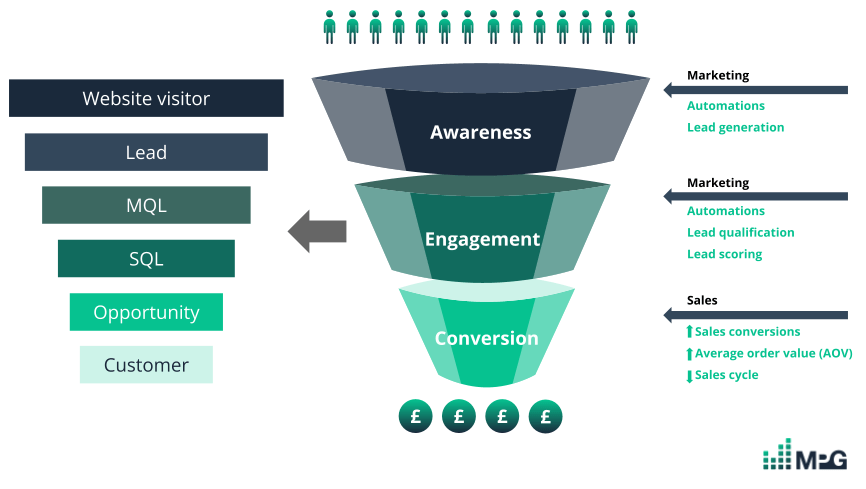Commercial marketing: the ‘goldmine’ for spex revenue growth
In-person events are back with a bang and with them the promise of rapidly growing sponsorship and exhibitions (spex) revenues - especially when the event organiser can also offer a strong digital audience linked to their events.
So, how can a business with a portfolio of strong events and associated digital audiences make the most of this opportunity? The answer is commercial marketing - in other words, the marketing that drives awareness, interest, engagement, leads and commitment from companies that would benefit from spex opportunities available.
Based on what was traditionally called ‘exprom’ by the large trade show organisers, commercial marketing is emerging as a ‘next generation’ area of marketing in events businesses - specifically to support spex sales teams attract, retain and upsell clients on high-value packages.
The ROI on a commercial marketing programme should be significant (600%+), but only if money is well spent on the right kind of marketing. And therein lies the challenge…which is this: the knowledge, tools and skills to do ‘the right kind of marketing’ to support spex sales teams to deliver strongly growing commercial revenues typically don’t sit within today’s events businesses.
Event marketers typically know how to deploy marketing approaches that are specifically suited to attracting delegates and show visitors - which, to keep things simple, we will call ‘event audience marketing’. Commercial marketing requires a very DIFFERENT methodology and set of performance metrics (KPIs) compared to event audience marketing. This also requires a different knowledge base, skillset and mindset in marketers.
Commercial marketers should be focused on ensuring the value proposition for sponsors and exhibitors is positioned and communicated well to positively influence both returning and new spex clients. This spex value proposition is very different for spex clients than it is for the audience - even though it is essentially focused on the same product. Two value propositions from one product; two sides of the same coin. Although this is what makes events a wonderful model - especially if you can directly monetise both ‘buyside’ (attendees) and ‘sell side’ (spex clients) - it also means you’re effectively marketing two different products to two different target markets, in two different ways.
Securing revenue from event audiences is more difficult than ever. This is not to say that a valuable event experience shouldn't be paid for by a delegate. But it does mean growing delegate revenue fast is very challenging, especially if a key goal is to ensure the quality of the audience is ‘top notch’ and attractive to potential spex clients.
In the next couple of years, our prediction is that spex clients will drive revenue growth in most events businesses. This will require very good event audience marketing as the right audience is what spex clients are effectively paying for. And it means commercial marketing is also needed to attract new spex clients while also supporting the retention of existing clients (who now have far more choice about where to spend their marketing budgets, and who may have therefore become a lot more price sensitive.
Never underestimate the importance of a steady stream of new spex clients. They can be retained and upsold in future years, and also provide helpful ‘competition’ for existing spex clients - giving your salespeople a stronger negotiating position.
Also, don’t underestimate how helpful it can be to your sales team to have a strong commercial marketing programme running all year round to deliver a steady stream of new leads into their pipelines.
Recently, 12-month programmes run by Team MPG have delivered full payback within 3 months (i.e. money committed to the full 12-month programme has been covered by resulting sales within 3 months), with the campaigns typically delivering an ROI of over 600%. This means for every £1 spent on commercial marketing, £6 is generated from spex clients who would not otherwise have heard of the event, let alone paid attention to the spex opportunities on offer and raised their hands via a web form to indicate their interest. And that’s just the direct revenue generated for that period - not counting leads converted in future years or the lifetime value of new clients retained and upsold.
Commercial marketing won’t work without sales and marketing integration
An integrated sales and marketing approach is essential for success! And it is important to automate as much of this process as you can - which with tools available like HubSpot*, is relatively straightforward. (*MPG are HubSpot Partners - have a look here to see how we can help you get the best tech stack).
Here is MPG’s recommended step-by-step process to achieve a well-integrated spex sales and commercial marketing setup:

STEP #1 Build a market map - identifying key people in your target market as a starting point for building your customer personas. Typically your market map would include information for each customer segment such as company type, job function/title/seniority and relevant geographical information e.g. countries or region. Develop personas that explore goals, pain points and motivators of your target spex customer.
STEP #2 Determine the size of your market. How many potential spex clients are out there? You may be surprised how large the potential pool of clients really is! And you may find you only have a very small percentage of these in your database, so commercial marketing activity will be needed to grow this list (see next point…)
STEP #3 Grow your database - from both inbound marketing efforts (e.g. PPC & social media) and targeted data research, ensure the list of potential spex clients on your database is both large enough and easily identified and targeted with relevant email comms.
STEP #4 Optimise your website so that potential new spex clients who hit your website are motivated to fill in forms so they become spex sales leads. You will need analytics well set up on your site for this to work.
STEP #5 Deploy well-optimised inbound marketing tactics e.g. content marketing, social media, advocacy marketing, SEO and PPC. All of these efforts are needed to give you a steady stream of well-qualified spex leads, and can work wonders in re-engaging lapsed spex clients and convincing annually returning clients to spend again, and ideally spend more!
STEP #6 Qualify and nurture leads, by using marketing and sales automations such as lead scoring and automated messages. Well-set-up automations can ensure spex leads are kept warm until a conversation is possible, and can also ensure they’re contacted at exactly the right time to have the best kind of sales conversation - most likely to lead to a sale.
STEP #7 Measure, measure, measure. If you’re not measuring the results of the joined-up marketing and sales effort you won’t know what is and is not working. Success is driven by strong visibility of campaign effectiveness, and also core KPIs supported by commercial marketing activity - i.e. # of marketing qualified leads (MQLs); # of sales made from these MQLs; conversion rate from MQL to sale; revenue from MQLs; average order value of sales from MQLs; and ideally also the length of the sales cycle. You need an evidence-based, data-led approach to get an ROI of 600%+. Ask MPG about our Commercial Marketing Dashboards.

 Don’t miss the boat on this one! Commercial marketing really is the key to great riches - when you get it right. Hopefully the knowledge we have shared in this piece will help you achieve this!
Don’t miss the boat on this one! Commercial marketing really is the key to great riches - when you get it right. Hopefully the knowledge we have shared in this piece will help you achieve this!
Did you know that Team MPG delivers Commercial Marketing programmes for a number of leading events and membership brands.
Get in touch to find out how we deliver a 600%+ ROI, again and again.



